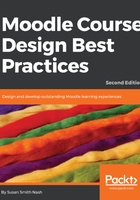
Organizing Your Course
Now that you've determined what you'd like your students to be able to do after they have completed your course, and as you're done with the initial planning stages, you are now ready to start building the framework for your course.
Selecting the initial course settings and format allows you to organize your course. In this chapter, we'll learn how to build a structure that accommodates your course content, activities, resources, information, and assessments. In Chapter 2, Planning Your Course, you learned how to plan your course with learning outcomes in mind. Now, as we start adding content, thinking about how students will demonstrate their knowledge, skills, and attitudes will help us effectively organize the course. We'll start by building a framework.
As we start to develop the framework, we will include some of the most commonly used elements in Moodle courses. Keep in mind, however, that we're not including everything. Instead, we're aiming to build a basic framework in a step-by-step manner so that, by the end of this chapter, you will be in a position to add the content and activities in your course in a clear, coherent way, all the while keeping the overall learning outcomes in mind.
In this chapter, we'll discuss the following topics in terms of organizing your course:
- Course goals
- Course settings
- Course format
- Customizing the appearance of your course
A great way to start thinking about the best structure for your course is by reflecting upon what you want your students to be able to do by the end of the course and the course material that you'll need to include for them to demonstrate that they've achieved their learning outcomes. Keep in mind that it's best to keep your list simple and focused on the essential items rather than on all the potential supplemental or optional material, that might enrich your list but isn't vital.
At this point, you may feel a bit overwhelmed as you review your list and wonder, "What am I going to do with all this material?"
Moodle makes your decisions fun and intuitive because it comes with a number of options that will help you both organize and design your course at the same time.
Our goal is to create a course framework that we can use as a template with which to create functionally consistent courses for use in college degree programs, certificate courses, corporate training, and so on, and what we are doing in this chapter represents a very important step towards achieving it. So, if we keep the big picture in mind and consider the needs and ultimate objectives of the stakeholders, from learning organization administrators to curriculum developers, instructional designers, professors/teachers, and students, we will be in a better position to make good decisions as we select the settings and options in Moodle. This will help us make sure that our course is well designed and functional, resulting in a positive learning experience.